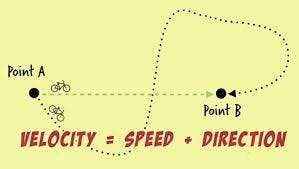Speed, in its simplest form, refers to how fast something is moving. It’s a scalar quantity, representing motion without regard to direction. At organizations, speed often manifests itself as tasks are completed or projects are executed. It’s about the sheer pace of activity.
On the other hand, velocity introduces an additional dimension by incorporating direction into the equation. Velocity is a vector quantity. At organizations, velocity not only means the rate of progress but also moving forward with purpose, navigating towards predetermined goals rather than merely staying busy.
People often conflate the two. Consider a scenario where you are diligently working on various tasks day in and day out. You are squarely focused on output, demonstrating impressive speed in your activities. However, if it fails to drive any outcome or contribute meaningfully to our company goals, you’re essentially moving in circles.
We often confuse being busy with being productive. It’s not uncommon for us to equate a flurry of activity with success but if we are not making any progress towards our goals, in terms of velocity, we are just static.
Don’t fall into this trap. Focus on outcomes over outputs. Before working on every task, ask yourself - what KPI this will influence? Is it contributing to our company goals? If not, ruthlessly prioritize.




